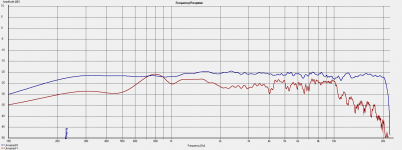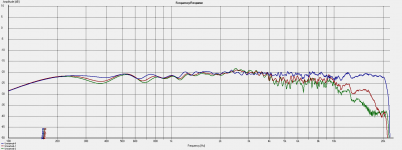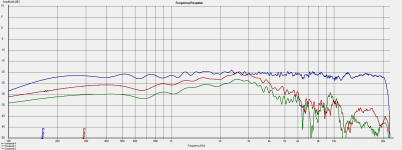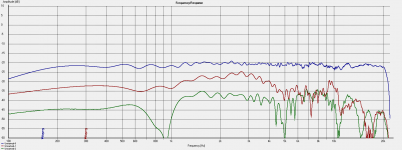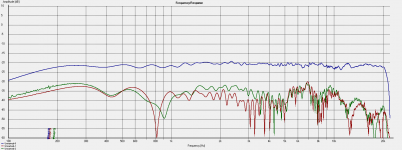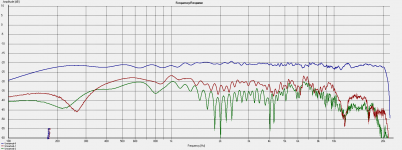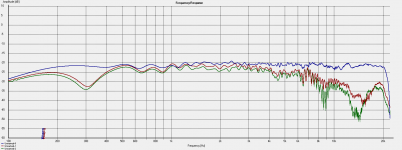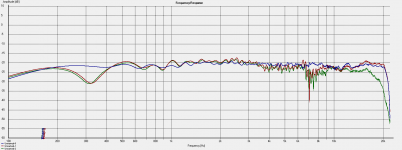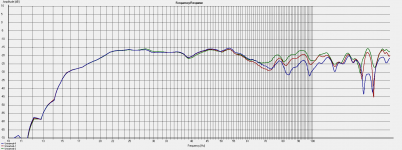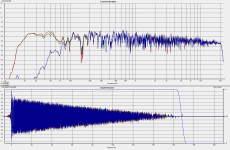Agreed. I am yet to explain the clarity and apparent lack of 'confusing reflections' that allows such excellent presentation of the sound stage.
I would support your proposition that this is more ear brain than room ear, and therefore may be less easy to properly describe with measurements alone.
I would support your proposition that this is more ear brain than room ear, and therefore may be less easy to properly describe with measurements alone.
Well done in trying all these different concepts. Your enthusiasm for the OB approach is coming through clearly. I'm interested that you are leaning towards thinking OB is good for small rooms. Can I ask a question here?
Ken, I'm not quite following here, can you explain this a little more please?
From one physicist to another, Keep up the good work,
Ian
Although OBs cause a lot of reflection, fundamentals and their harmonics to a large extent travel together, at least in the horizontal plane.
Ken
Ken, I'm not quite following here, can you explain this a little more please?
Well that's not such a great range geographically 🙂I've been listening to everything from Sibelius to Finnish Symphonic Metal,
Ken
From one physicist to another, Keep up the good work,
Ian
Small rooms
Ian,
thanks for the good question and comment. It's a long proper distance from Sibelius to Symphonic Metal, in both physical and musical space.
I was aware of the ambiguity when I wrote "small". I meant it in the sense of not having enough space to ensure sufficient distance for all the reflections with the speakers placed away from the walls, in a position that provides a good stereo-triangle setup.
My "room" - part of an open-plan space, is not all that small; according to a rough model of its modes, the Schroeder frequency is around 90Hz. That's why I was happy to see the OB reach down that far, though I don't regard this as a requirement.
I've heard dipole speakers (mostly electrostatics of various types) in larger rooms (double or triple the volume) and they sounded great, especially on chamber music. These were set up farther from the front wall than I can manage, however. This was long ago and I've not thought much about using dipoles until a few weeks ago.
Before getting to dipoles:
There's been a lot of discussion on waveguide threads, especially, about the frequency at which it makes sense to have a monopole to directional transition - a major design choice with waveguides (diameter). You can find arguments for pattern control down to ~1kHz, or an octave or so lower, discussed by Geddes and others.
The fractal array experiments in the After 10 years thread were designed to avoid baffle-step, and at least partly help with the problem (they are shallow enough that the front wall acts as an extended baffle, and the radiation pattern can't extend beyond 180 degrees). The outer array is ~50cm wide broadly like some of the larger waveguide or typical synergy speakers - though the latter go larger (even ignoring secondary flares).
On to dipoles: here I refer only to the horizontal plane, see another post for my thoughts on the vertical plane.
The measurements I made suggest that my new OBs work well as dipoles over the whole range - in the sense that they have minimum radiation at the sides.
At some frequencies, the pattern narrows a little due to the individual drivers - the bass is starting to narrow at 660Hz, the mid a little at 3kHz and then, as usual, the tweeter narrows considerable. It narrows slightly between 5 and 10kHz and then progressively above that.
The overall result is, however, relatively benign in terms of radiated power vs. on-axis response. I believe this is why the speakers have been incredibly easy to balance. This stands in contrast to waveguides, especially with narrow coverage, the fractal arrays which were a comparative nightmare, and typical speakers with dome tweeters which tend to have much larger fluctuations near the crossover(s) -ven in the horizontal plane)
I hope that makes it a little clearer.
Ken
Ian,
thanks for the good question and comment. It's a long proper distance from Sibelius to Symphonic Metal, in both physical and musical space.
I was aware of the ambiguity when I wrote "small". I meant it in the sense of not having enough space to ensure sufficient distance for all the reflections with the speakers placed away from the walls, in a position that provides a good stereo-triangle setup.
My "room" - part of an open-plan space, is not all that small; according to a rough model of its modes, the Schroeder frequency is around 90Hz. That's why I was happy to see the OB reach down that far, though I don't regard this as a requirement.
I've heard dipole speakers (mostly electrostatics of various types) in larger rooms (double or triple the volume) and they sounded great, especially on chamber music. These were set up farther from the front wall than I can manage, however. This was long ago and I've not thought much about using dipoles until a few weeks ago.
Before getting to dipoles:
There's been a lot of discussion on waveguide threads, especially, about the frequency at which it makes sense to have a monopole to directional transition - a major design choice with waveguides (diameter). You can find arguments for pattern control down to ~1kHz, or an octave or so lower, discussed by Geddes and others.
The fractal array experiments in the After 10 years thread were designed to avoid baffle-step, and at least partly help with the problem (they are shallow enough that the front wall acts as an extended baffle, and the radiation pattern can't extend beyond 180 degrees). The outer array is ~50cm wide broadly like some of the larger waveguide or typical synergy speakers - though the latter go larger (even ignoring secondary flares).
On to dipoles: here I refer only to the horizontal plane, see another post for my thoughts on the vertical plane.
The measurements I made suggest that my new OBs work well as dipoles over the whole range - in the sense that they have minimum radiation at the sides.
At some frequencies, the pattern narrows a little due to the individual drivers - the bass is starting to narrow at 660Hz, the mid a little at 3kHz and then, as usual, the tweeter narrows considerable. It narrows slightly between 5 and 10kHz and then progressively above that.
The overall result is, however, relatively benign in terms of radiated power vs. on-axis response. I believe this is why the speakers have been incredibly easy to balance. This stands in contrast to waveguides, especially with narrow coverage, the fractal arrays which were a comparative nightmare, and typical speakers with dome tweeters which tend to have much larger fluctuations near the crossover(s) -ven in the horizontal plane)
I hope that makes it a little clearer.
Ken
Glad you are enjoying your new speaker experiment 🙂
Audioslave - Show Me How to Live (Official Video) - YouTube
This is one of my go to tracks for testing speakers, when the chorus kicks in around 1:45 in the youtube video. All my Linkwitz dipoles failed quite miserably. I realize this will not be to everyone's taste but I grew up listening to this sort of thing so if a speaker can't do it justice it isn't for me.
In contrast this one has never sounded better than on on the LX521
James Bay - Hold Back The River - YouTube
Audioslave - Show Me How to Live (Official Video) - YouTube
This is one of my go to tracks for testing speakers, when the chorus kicks in around 1:45 in the youtube video. All my Linkwitz dipoles failed quite miserably. I realize this will not be to everyone's taste but I grew up listening to this sort of thing so if a speaker can't do it justice it isn't for me.
In contrast this one has never sounded better than on on the LX521
James Bay - Hold Back The River - YouTube
Congratulations kstrain!
Sorry, I've been busy with summer house and dog training lately, I missed this thread until now. I'm very glad to hear that you find subwoofer integration problem-free. Delay settings are very important, and I have learned to check step response and reverse polarity methods, wiht two drivers at the time (tweeter typically has 0 delay)
I think the main reason for having good stereo image and wide soundstage is the horizontal continuos dipole pattern -lateral reflections are delayed enough and crosstalk towards midline is minimal. This will expain the magic to me (not being a physicist)
I'm waiting to see some polar measurrements, indoor at 1m with the speaker in the middle of the room will be ok down to say 200-500Hz with appropriate gating (I use 20ms quite often but it reveals floor bounce)
And I haven't been tired of listening to dipoles for the last 7-8 years - and supposing to have these as my premium set till I die!
But, what decice or software are you using for xo/dsp/delay?
Sorry, I've been busy with summer house and dog training lately, I missed this thread until now. I'm very glad to hear that you find subwoofer integration problem-free. Delay settings are very important, and I have learned to check step response and reverse polarity methods, wiht two drivers at the time (tweeter typically has 0 delay)
I think the main reason for having good stereo image and wide soundstage is the horizontal continuos dipole pattern -lateral reflections are delayed enough and crosstalk towards midline is minimal. This will expain the magic to me (not being a physicist)
I'm waiting to see some polar measurrements, indoor at 1m with the speaker in the middle of the room will be ok down to say 200-500Hz with appropriate gating (I use 20ms quite often but it reveals floor bounce)
And I haven't been tired of listening to dipoles for the last 7-8 years - and supposing to have these as my premium set till I die!
But, what decice or software are you using for xo/dsp/delay?
More good points
Juhazi,
thank you. Your Aino gradient thread was of course highly informative.
For no good reason I had not paid as much attention to OB as waveguides over the past decade - I had a lot of catching up to do, but did not want to get into another decade of over-thinking.
I'm using a pair of DCX2496, which I always use to get things set up. I might go to in-PC convolution filters later for most of the channels (I'm using all 12, as I have two "surround" speakers, four subs and the six main channels). There's less motivation than usual as ideal LR 4th order filters work well.
Your points about delays are well taken. I measure each sub separately with a list of room mode frequencies in mind. My first troubles come at 32Hz - the second mode. Then from the upper 40s to about 90Hz is a mess.
Up to 35Hz, the huge BP sub at one side of the room dominates. The remaining three subs can be moved around to some extent along the front wall, and part way along one "side wall" (the rest of which is an opening to another room). I know by now some of the combinations that work better, though of course I needed to tune them to integrate with the mains. Phase adjustments help with that. There's always more than one solution that gives a flat result - one maximally additive and one with more cancellation - that leads to more boom outside the listening area. I've got it down so that there are no big peaks, but there are a couple of dips still. Good enough for now.
I'll have a go at measuring at some more angles - probably a bit less than 20ms gating due to my ceiling height, we'll see.
Ken
Juhazi,
thank you. Your Aino gradient thread was of course highly informative.
For no good reason I had not paid as much attention to OB as waveguides over the past decade - I had a lot of catching up to do, but did not want to get into another decade of over-thinking.
I'm using a pair of DCX2496, which I always use to get things set up. I might go to in-PC convolution filters later for most of the channels (I'm using all 12, as I have two "surround" speakers, four subs and the six main channels). There's less motivation than usual as ideal LR 4th order filters work well.
Your points about delays are well taken. I measure each sub separately with a list of room mode frequencies in mind. My first troubles come at 32Hz - the second mode. Then from the upper 40s to about 90Hz is a mess.
Up to 35Hz, the huge BP sub at one side of the room dominates. The remaining three subs can be moved around to some extent along the front wall, and part way along one "side wall" (the rest of which is an opening to another room). I know by now some of the combinations that work better, though of course I needed to tune them to integrate with the mains. Phase adjustments help with that. There's always more than one solution that gives a flat result - one maximally additive and one with more cancellation - that leads to more boom outside the listening area. I've got it down so that there are no big peaks, but there are a couple of dips still. Good enough for now.
I'll have a go at measuring at some more angles - probably a bit less than 20ms gating due to my ceiling height, we'll see.
Ken
Music and speakers
Fluid,
thanks for the music suggestions - both entirely new to me. I'll try them both later (though now it's not a blinded experiment and I can feel the bias already).
Sometimes I notice my listening drift away from certain recordings or genres, and I with the fractal arrays I was favoring good, simple, acoustic recordings which sounded sharp in contrast to heavily mixed musing that sounded "hazy".
It's too soon to tell if there's going to be a problem like that with the OBs.
Ken
Fluid,
thanks for the music suggestions - both entirely new to me. I'll try them both later (though now it's not a blinded experiment and I can feel the bias already).
Sometimes I notice my listening drift away from certain recordings or genres, and I with the fractal arrays I was favoring good, simple, acoustic recordings which sounded sharp in contrast to heavily mixed musing that sounded "hazy".
It's too soon to tell if there's going to be a problem like that with the OBs.
Ken
I'll try not to bias you any further but I would be interested in your impressions when you get a chance to listen.Fluid,
thanks for the music suggestions - both entirely new to me. I'll try them both later (though now it's not a blinded experiment and I can feel the bias already).
I found the same with the LX521, I gravitated towards "audiophile" music as it sounded so good with them. I could never get on with the rock music I grew up with and that was the deal breaker for me (Iron Maiden being a particular disappointment). I did find that some damping on the front wall lined up with where the woofers would fire helped.Sometimes I notice my listening drift away from certain recordings or genres, and I with the fractal arrays I was favoring good, simple, acoustic recordings which sounded sharp in contrast to heavily mixed musing that sounded "hazy".
I just had a listen fluid and it sounds great - I love that Audioslave Album and forgot I had it on CD!
I wonder if it is to do with the mid bass? I am using a 15" Eminence Deltalite for the 100-600Hz range and I feel like this track lives in that range - not sure what the LX521 uses for that range though?
I wonder if it is to do with the mid bass? I am using a 15" Eminence Deltalite for the 100-600Hz range and I feel like this track lives in that range - not sure what the LX521 uses for that range though?
Music
The James Bay and Audioslave tracks both unfamiliar to me. I listened to both from YT, as I don't use a streaming service.
James Bay first - the mix came over clear with a lot of space among instruments and around the vocalist. His voice came over as natural and well recorded. The only thing that seemed slightly odd is the image placement of the solo guitar relative to the vocal - I checked with headphones which gave the same impression.
The "official" Audioslave track I get served with sounds dull. I prefer the "HD" track put up by w84ChA0s which in the versions I get sounds better. It's about 6dB louder too and differently compressed. Perhaps it's an album version or something that's been mixed differently from the start.
I ended up listening to both versions several times. The change from drum to bass emphasis and the crescendos work well to create power and weight at different points. The vocals are of course excellent - unusual pitch change technique.
To keep this relevant for speaker testing: I like the heavy bass with fundamentals in the 35-45Hz range a lot of the time, and harmonics bridging into the OB range. I didn't notice any problems. I enjoyed this track more.
Ken
The James Bay and Audioslave tracks both unfamiliar to me. I listened to both from YT, as I don't use a streaming service.
James Bay first - the mix came over clear with a lot of space among instruments and around the vocalist. His voice came over as natural and well recorded. The only thing that seemed slightly odd is the image placement of the solo guitar relative to the vocal - I checked with headphones which gave the same impression.
The "official" Audioslave track I get served with sounds dull. I prefer the "HD" track put up by w84ChA0s which in the versions I get sounds better. It's about 6dB louder too and differently compressed. Perhaps it's an album version or something that's been mixed differently from the start.
I ended up listening to both versions several times. The change from drum to bass emphasis and the crescendos work well to create power and weight at different points. The vocals are of course excellent - unusual pitch change technique.
To keep this relevant for speaker testing: I like the heavy bass with fundamentals in the 35-45Hz range a lot of the time, and harmonics bridging into the OB range. I didn't notice any problems. I enjoyed this track more.
Ken
For me with the Audioslave track the issue comes in the chorus with the cymbal crashes and screamier vocals, with most speakers it is just too much. The rest of the track is much simpler and rarely a problem. It's a difficult test for me so if these styles of dipoles can handle it that's a positive.
Having more cone area in the 100 to 600Hz region is different to the LX521 where that is handled by an 8". There is a lot of EQ on that driver so it could be part of the problem.
The Orion and LX521 were different in some ways, the tonality was very similar but overall the differences seemed to come more from the full dipole vs partial dipole radiation and the woofers being a lot better in the LX521.
I liked them both for different reasons, overall I would probably pick the partial dipole for rock and the full dipole for acoustic and music with space. I found that the full dipole all the way to the highest frequencies was very revealing of clipping and overs in recordings that I had not heard before but once heard could not be unheard. London Grammar's "Strong" being an example.
Having more cone area in the 100 to 600Hz region is different to the LX521 where that is handled by an 8". There is a lot of EQ on that driver so it could be part of the problem.
The Orion and LX521 were different in some ways, the tonality was very similar but overall the differences seemed to come more from the full dipole vs partial dipole radiation and the woofers being a lot better in the LX521.
I liked them both for different reasons, overall I would probably pick the partial dipole for rock and the full dipole for acoustic and music with space. I found that the full dipole all the way to the highest frequencies was very revealing of clipping and overs in recordings that I had not heard before but once heard could not be unheard. London Grammar's "Strong" being an example.
Measurements all around ...
It took me a few goes to find a way to measure all round Juhazi suggested in post #25.
The cables are too short to rotate the speakers in the middle of the room, so I compromised and did a bit of rotation and measured two quadrants (front right, rear left) plus some extra measurements moving the mic. Part way through I realized that the acoustic center is not exactly where I expected, so I probably rotated around the wrong point by about 2cm, somewhere close to the rear surface of the baffle (in other words the dipole null is not at +/-90 degrees from the listening=tweeter axis, but slightly behind.
Another compromise is measuring at 80cm and 15 degree steps. I positioned the mic within 2cm of the correct azimuthal position and about 1cm radially, from the 3D center of the tweeter, which was probably not exactly the true origin, as noted above.
All measurements are using Holm Impulse. All the measurements in this series are gated below 200Hz. I tried to keep the same gating, but had to change for a few angles on the rear right quadrant, as I couldn't rotate the speaker enough and was getting close to hard furniture, that's fixed in place.
I thought I was gating out the floor bounce in these measurements, but I think my eye was distracted by a mid-tweeter impulse at a similar distance from a table, and the floor bounce from the bass drive was in most of the measurements at 80cm. I had put some cushions etc. on the floor, but should have checked more carefully first. The effect is a bit more ripple than I need have had. If the gating mark for a channel can't be seen, it's behind another one on the plot, not off the plot.
The axis is zero degrees, I'll use R for measurements as I moved the mic rightward and backward, and L for measurements to the left of the axis, leaving 180 degrees for the rear.
Before embarking on that, as a prelude I investigated the mid-tweeter crossover, as it was meant to have it's first lobe on the ceiling bounce direction, so I was hoping for a really good match of ceiling bounce spectrum to the direct spectrum. For the floor bounce I'm relying on my brain to figure it out. More thoughts on that below, stimulated by an observation during the measurements.
The on-axis curve (blue) is left for reference and I'll note the red and green curves in that order each time until otherwise stated.
Vertical measurements on-axis horizontally
First plot - 0, 15 degrees up and 30 degrees up. The null at the mid-tweet XO is meant to be around 22 degrees (forget exactly) such that the ceiling reflection, a bit under 45 degrees up is in the next lobe. The +30 degree curve needed shorter gating due to the ceiling reflection.
Second plot shows the response at roughly the angle corresponding to the ceiling reflection at the listening position, but measured at 80cm. The mic positioning is less precise here than in most measurements. The bass-mid crossover shows up in excess, but the choice of close-mounting the GRS mid and tweeter worked out (for my room). I'm really happy with this (perhaps I shouldn't be, but it's the best I've made).
Long enough - next post the first half of the horizontal measurements.
Ken
It took me a few goes to find a way to measure all round Juhazi suggested in post #25.
The cables are too short to rotate the speakers in the middle of the room, so I compromised and did a bit of rotation and measured two quadrants (front right, rear left) plus some extra measurements moving the mic. Part way through I realized that the acoustic center is not exactly where I expected, so I probably rotated around the wrong point by about 2cm, somewhere close to the rear surface of the baffle (in other words the dipole null is not at +/-90 degrees from the listening=tweeter axis, but slightly behind.
Another compromise is measuring at 80cm and 15 degree steps. I positioned the mic within 2cm of the correct azimuthal position and about 1cm radially, from the 3D center of the tweeter, which was probably not exactly the true origin, as noted above.
All measurements are using Holm Impulse. All the measurements in this series are gated below 200Hz. I tried to keep the same gating, but had to change for a few angles on the rear right quadrant, as I couldn't rotate the speaker enough and was getting close to hard furniture, that's fixed in place.
I thought I was gating out the floor bounce in these measurements, but I think my eye was distracted by a mid-tweeter impulse at a similar distance from a table, and the floor bounce from the bass drive was in most of the measurements at 80cm. I had put some cushions etc. on the floor, but should have checked more carefully first. The effect is a bit more ripple than I need have had. If the gating mark for a channel can't be seen, it's behind another one on the plot, not off the plot.
The axis is zero degrees, I'll use R for measurements as I moved the mic rightward and backward, and L for measurements to the left of the axis, leaving 180 degrees for the rear.
Before embarking on that, as a prelude I investigated the mid-tweeter crossover, as it was meant to have it's first lobe on the ceiling bounce direction, so I was hoping for a really good match of ceiling bounce spectrum to the direct spectrum. For the floor bounce I'm relying on my brain to figure it out. More thoughts on that below, stimulated by an observation during the measurements.
The on-axis curve (blue) is left for reference and I'll note the red and green curves in that order each time until otherwise stated.
Vertical measurements on-axis horizontally
First plot - 0, 15 degrees up and 30 degrees up. The null at the mid-tweet XO is meant to be around 22 degrees (forget exactly) such that the ceiling reflection, a bit under 45 degrees up is in the next lobe. The +30 degree curve needed shorter gating due to the ceiling reflection.
Second plot shows the response at roughly the angle corresponding to the ceiling reflection at the listening position, but measured at 80cm. The mic positioning is less precise here than in most measurements. The bass-mid crossover shows up in excess, but the choice of close-mounting the GRS mid and tweeter worked out (for my room). I'm really happy with this (perhaps I shouldn't be, but it's the best I've made).
Long enough - next post the first half of the horizontal measurements.
Ken
Attachments
Measurements, horizontal to the right
See the previous post for details of the measurements. I'll keep this one to results and comments.
Plot one: on axis (blue); 15 degrees (red), 30 degrees (green);
Plot two: 0, 45 and 60 degrees;
Plot three: 0, 75 and 90 degrees;
Plot four 0, 97 (approx) and 105 degrees;
Observations
-the response is reasonably flat out to 30 degrees, these are meant to cover a modest listening area, toed in with ear on the tweeter axis. In stereo, by ear, I find it hard to sense a problem with the fall off out to that angle.
- especially at 45 and 60 degrees, there's excess energy at the mid-tweeter XO - deviates from the dipole response around there
- 90 and 97 degrees bracket the null for the tweeter, the latter is close to the null for the mid
180 and other angles behind the speaker are in my next post.
Ken
See the previous post for details of the measurements. I'll keep this one to results and comments.
Plot one: on axis (blue); 15 degrees (red), 30 degrees (green);
Plot two: 0, 45 and 60 degrees;
Plot three: 0, 75 and 90 degrees;
Plot four 0, 97 (approx) and 105 degrees;
Observations
-the response is reasonably flat out to 30 degrees, these are meant to cover a modest listening area, toed in with ear on the tweeter axis. In stereo, by ear, I find it hard to sense a problem with the fall off out to that angle.
- especially at 45 and 60 degrees, there's excess energy at the mid-tweeter XO - deviates from the dipole response around there
- 90 and 97 degrees bracket the null for the tweeter, the latter is close to the null for the mid
180 and other angles behind the speaker are in my next post.
Ken
Attachments
round the back
Following on from my last two posts, measurements round the back of the speakers, starting from 180 degrees (directly behind) and coming forward on the left side (front view). See two posts ago for details.
Plot 1: 0, 180 and 165 degrees;
Plot 2: 0, 150 and 135 degrees;
Plot 1: 0, 120 and 105 degrees;
Plot 1: 0, 97 and 90 degrees;
We'd already seen the cavity resonance due to the baffle behind the tweeter. It makes a narrow hole directly backward, and spread the energy out to the sides. After some thought and looking for it in reflections around the room, I'm not planning to change that.
During these measurements a few other ideas came to mind - my next post to follow soon.
Ken
Following on from my last two posts, measurements round the back of the speakers, starting from 180 degrees (directly behind) and coming forward on the left side (front view). See two posts ago for details.
Plot 1: 0, 180 and 165 degrees;
Plot 2: 0, 150 and 135 degrees;
Plot 1: 0, 120 and 105 degrees;
Plot 1: 0, 97 and 90 degrees;
We'd already seen the cavity resonance due to the baffle behind the tweeter. It makes a narrow hole directly backward, and spread the energy out to the sides. After some thought and looking for it in reflections around the room, I'm not planning to change that.
During these measurements a few other ideas came to mind - my next post to follow soon.
Ken
Attachments
Random measurements - the end for now
Thanks again to Juhazi for pushing me to do the measurements, though I didn't do 10 degree steps this time ...
This post covers three quite different measurements (in four plots).
Floor bounce: Plot 1, I moved the mic back, on the tweeter axis to 240cm (red) then 160cm (green) the blue trace is the original 80cm. I did this in part because I'd noticed that some effects I had been attributing to floor reflections were more likely furniture reflections and I moved things around. Note that the speaker was not in its usual position (i.e. different from earlier in the thread, though it's back there now). I'll skip to Plot 4 - this is measured in the vertical listening window. It gives me an idea for listening at different heights and seeing how well my hearing tunes out the floor bounce - the response is sufficiently consistent at other frequencies that it might be a worthwhile experiment.
(Turns out I'm listening to Floor as I write this - Nightwish)
Plot 2 is a check of the power response of an OB combined with my four subwoofers. The subs were reduced 3dB to allow for only driving one OB, which probably leaves them loud by between 0 and 3 dB - the measurements were not at the usual listening position. I'm happy how flat the response is given that it's not measured at the target location. I think I might have hit on a lucky distribution and setup of subs.
There's a dip around 90Hz due to the transition from monopoles to dipoles, as noted above, reaching the Schroeder frequency (90Hz+/- a few) was a design requirement. I can't prove it's a good choice, but bass instruments with harmonics bridging the transition sound great. Dipole bass advocates would no transition at all... The red trace has the wrong setting on one of the subs and is with the mic in a different position, I left it in.
Blue trace, no subs, Green trace, four subs.
The lowest frequencies are from a bandpass sub that was meant to be flat down to 18Hz in room (designed for the room mode). The house has been extended and said room mode is now 15Hz. I doubt it makes a difference.
Plot 3 resulted from my curiosity to check the reverb time of my room. This is measured with the speakers back in position (actually I made an error of about 15cm on one and I think I fixed that after this measurement, so not quite). The mic is equidistant from the speakers to within 5mm (laser measure). I present this as a curiosity, it can be compared with Plot 2.
Comments or questions most welcome on any of the above. I hope it's useful to someone, especially as concerns the GRS drivers and ideas for baffles for them.
I can't say how pleased I am with the sound - I'm at that stage where I have to listen to everything, and that's going to take months - I've hardly touched my favorites and there are whole genres to explore.
Ken
Thanks again to Juhazi for pushing me to do the measurements, though I didn't do 10 degree steps this time ...
This post covers three quite different measurements (in four plots).
Floor bounce: Plot 1, I moved the mic back, on the tweeter axis to 240cm (red) then 160cm (green) the blue trace is the original 80cm. I did this in part because I'd noticed that some effects I had been attributing to floor reflections were more likely furniture reflections and I moved things around. Note that the speaker was not in its usual position (i.e. different from earlier in the thread, though it's back there now). I'll skip to Plot 4 - this is measured in the vertical listening window. It gives me an idea for listening at different heights and seeing how well my hearing tunes out the floor bounce - the response is sufficiently consistent at other frequencies that it might be a worthwhile experiment.
(Turns out I'm listening to Floor as I write this - Nightwish)
Plot 2 is a check of the power response of an OB combined with my four subwoofers. The subs were reduced 3dB to allow for only driving one OB, which probably leaves them loud by between 0 and 3 dB - the measurements were not at the usual listening position. I'm happy how flat the response is given that it's not measured at the target location. I think I might have hit on a lucky distribution and setup of subs.
There's a dip around 90Hz due to the transition from monopoles to dipoles, as noted above, reaching the Schroeder frequency (90Hz+/- a few) was a design requirement. I can't prove it's a good choice, but bass instruments with harmonics bridging the transition sound great. Dipole bass advocates would no transition at all... The red trace has the wrong setting on one of the subs and is with the mic in a different position, I left it in.
Blue trace, no subs, Green trace, four subs.
The lowest frequencies are from a bandpass sub that was meant to be flat down to 18Hz in room (designed for the room mode). The house has been extended and said room mode is now 15Hz. I doubt it makes a difference.
Plot 3 resulted from my curiosity to check the reverb time of my room. This is measured with the speakers back in position (actually I made an error of about 15cm on one and I think I fixed that after this measurement, so not quite). The mic is equidistant from the speakers to within 5mm (laser measure). I present this as a curiosity, it can be compared with Plot 2.
Comments or questions most welcome on any of the above. I hope it's useful to someone, especially as concerns the GRS drivers and ideas for baffles for them.
I can't say how pleased I am with the sound - I'm at that stage where I have to listen to everything, and that's going to take months - I've hardly touched my favorites and there are whole genres to explore.
Ken
Attachments
I can't say how pleased I am with the sound - I'm at that stage where I have to listen to everything, and that's going to take months - I've hardly touched my favorites and there are whole genres to explore.
Ken
Well done Ken on a great outcome and build!
Lovely measurements too!
This last sentence sums up exactly where I am with my similar OB build! I am so glad I put it on DIYaudio - I wasn't going to bother, I haven't put quite a few of my recent builds on there (including a turntable I made which took me ages!!) - but to hear it maybe helped to prod you to have another go with OB too - really makes all the effort worthwhile 😀
One question I have though - this is my first OB design - I see you tried others in the past and didn't get on so well - do you therefore feel this combination of minimal baffle and GRS drivers has something different to the 'usual' OB designs?
Last edited:
No doubt
Bushmeister,
it's 100% down to your thread that I have these speakers. Post #3 had me hooked, and post #12 (with the crossover estimates) pushed me to start designing. Clock started on June 30th when I read post #12, job done on July 12th when I posted the #1 above.
I'd had a mental blind spot but within an hour of reading #12 I'd come up with the design in all but a couple of details. I ordered the GRS drivers a day or two later (from Netherlands) and spent a few days musing on which bass to use (given the baffle shape, already fixed, including the position of the bass driver). The baffle allows a 15".
Today, on another thread that I glanced at, Juhazi has posted that designing dipoles is easy, and I tend to agree. There are the same crossover questions to answer as with any multiway, but the GRS drivers give a strong push to one solution (1.4 wavelengths at crossover, which works in my room for ceiling bounce) and from there it all fell into place.
The aspect that took a while was choosing the bass drive - the range of choice available in pro-drivers is huge. Though I've usually used B&C (plus some PD and cheaper Faital pro), I took a wide view. I looked at some 15s and wasn't convinced they'd reach high enough (I wanted margin), yet 12s weren't right either. When I found/remembered the 14NDL76, the decision was made.
The previous OBs I had were 8" drivers on a setup remarkably close in shape to a scaled-down version of the current ones, i.e., wedge, tapered wings, not much larger than the driver. They were used in one iteration of the ambiphonic setup I posted about a long time ago. The drivers were spread out in an arc tweeters close-spaced in front (sometimes two sets), then the OBs, then the same bases I now have as two of my subwoofers at the sides. I was using a lot of DSP, FIR filters, 90 degree phase shifts (Hilbert transforms) etc., and using OB is a nice way to achieve constant source distance through the mid-band (I think that was 250Hz, to 1.2kHz or so). Unless I'm mistaken, with OB magnitude-only EQ produces a "perfect" source in the resistance-dominated range. The small OBs themselves were lost in the complexity of everything else and I hadn't had the chance to develop a liking.
Rambling again - I've not thought about those experiments for a decade. GeeLee Harpers came close with just the two speakers (with, or more usually without, ambiphonics or DRC). That was the start of my decade of trying to find something better. Wish I'd thought more about OBs then. I'd probably not have gone to the trouble of importing BG tweeters and mids back then, as it was an expensive process relative to my budget.
What happened is best - thank you.
Ken
ps. it's worth mentioning that one of the reasons I was primed to jump on OB was as I'd read
Full range line array for wall or corner placement
through more than twice, though I accidentally skipped some posts on one read. That thread is poised among almost every technique in loudspeaker design (somewhere in the thread, at least it feels like that), and I learned an enormous amount from the hundreds of simulations presented. So thanks owed to those folks too...
Bushmeister,
it's 100% down to your thread that I have these speakers. Post #3 had me hooked, and post #12 (with the crossover estimates) pushed me to start designing. Clock started on June 30th when I read post #12, job done on July 12th when I posted the #1 above.
I'd had a mental blind spot but within an hour of reading #12 I'd come up with the design in all but a couple of details. I ordered the GRS drivers a day or two later (from Netherlands) and spent a few days musing on which bass to use (given the baffle shape, already fixed, including the position of the bass driver). The baffle allows a 15".
Today, on another thread that I glanced at, Juhazi has posted that designing dipoles is easy, and I tend to agree. There are the same crossover questions to answer as with any multiway, but the GRS drivers give a strong push to one solution (1.4 wavelengths at crossover, which works in my room for ceiling bounce) and from there it all fell into place.
The aspect that took a while was choosing the bass drive - the range of choice available in pro-drivers is huge. Though I've usually used B&C (plus some PD and cheaper Faital pro), I took a wide view. I looked at some 15s and wasn't convinced they'd reach high enough (I wanted margin), yet 12s weren't right either. When I found/remembered the 14NDL76, the decision was made.
The previous OBs I had were 8" drivers on a setup remarkably close in shape to a scaled-down version of the current ones, i.e., wedge, tapered wings, not much larger than the driver. They were used in one iteration of the ambiphonic setup I posted about a long time ago. The drivers were spread out in an arc tweeters close-spaced in front (sometimes two sets), then the OBs, then the same bases I now have as two of my subwoofers at the sides. I was using a lot of DSP, FIR filters, 90 degree phase shifts (Hilbert transforms) etc., and using OB is a nice way to achieve constant source distance through the mid-band (I think that was 250Hz, to 1.2kHz or so). Unless I'm mistaken, with OB magnitude-only EQ produces a "perfect" source in the resistance-dominated range. The small OBs themselves were lost in the complexity of everything else and I hadn't had the chance to develop a liking.
Rambling again - I've not thought about those experiments for a decade. GeeLee Harpers came close with just the two speakers (with, or more usually without, ambiphonics or DRC). That was the start of my decade of trying to find something better. Wish I'd thought more about OBs then. I'd probably not have gone to the trouble of importing BG tweeters and mids back then, as it was an expensive process relative to my budget.
What happened is best - thank you.
Ken
ps. it's worth mentioning that one of the reasons I was primed to jump on OB was as I'd read
Full range line array for wall or corner placement
through more than twice, though I accidentally skipped some posts on one read. That thread is poised among almost every technique in loudspeaker design (somewhere in the thread, at least it feels like that), and I learned an enormous amount from the hundreds of simulations presented. So thanks owed to those folks too...
Last edited:
You are so very welcome! It seems with have both been on quite the journey then!
As you know I have synergies, low diffraction 4 ways, traditional sealed three ways, single driver full range (Mark Audio) speakers, and a number of 2 ways. Some DSP active, some completely passive, some analogue active, and of course the full rangers - without any crossovers at all.
I have tried ported bass, distributed sealed bass, DIY subs and commercial subs.
These will be the ones staying in my dedicated listening room
Interestingly if you look at SL's website he went on a similar journey to ours starting with sealed and ported speakers and then moved to open baffle and his final iteration of his OB designs - LX521 - he came to the same conclusions as JK's NAO Note's independently at around the same time - minimal baffles. The two designs are strikingly similar in many ways.
Anyway now I am rambling! Back to the music!
As you know I have synergies, low diffraction 4 ways, traditional sealed three ways, single driver full range (Mark Audio) speakers, and a number of 2 ways. Some DSP active, some completely passive, some analogue active, and of course the full rangers - without any crossovers at all.
I have tried ported bass, distributed sealed bass, DIY subs and commercial subs.
These will be the ones staying in my dedicated listening room
Interestingly if you look at SL's website he went on a similar journey to ours starting with sealed and ported speakers and then moved to open baffle and his final iteration of his OB designs - LX521 - he came to the same conclusions as JK's NAO Note's independently at around the same time - minimal baffles. The two designs are strikingly similar in many ways.
Anyway now I am rambling! Back to the music!
Update, and Full DCX filter settings (simple ones for GRS drivers)
I'm happier with these speakers than any others I've designed and built and am delving into all the music across several genres. It's ironic how little effort it took to make OBs compared to other approaches (especially MEH and fractal arrays).
1) as expected, I was able to simplify filters on mid and tweeter keeping response almost the same (there was some cancellation that could be removed by changing the gain and adjusting the filters while comparing before/after responses - the result is within 1dB at worst).
2) trying to hear if floor bounce, the most conspicuous feature on measurements near the listening position, matters much or not.
I address 1) in this post 2) to follow.
Here are the final DCX2496 filters - they've been stable now since around the time of the last measurements, and may provide a starting point for anyone else who takes a similar path. Or perhaps a little encouragement to use the GRS drivers - after working with them it's going to be hard to use anything else. The only reason I can see not to is to get wider dispersion at higher frequencies, but there's always a trade off (in some cases perhaps "only" money, but often more).
DCX users should recognize the notation I use below; I've added clues for those unfamiliar. Other than the bass-mid, and noting the almost resistive impedance of mid and tweeter, it would be simple to make passive crossovers: surprisingly so. Only the delay of about 1/9th of a wave at the crossover, to get the main lobe on to the tweeter axis is hard to achieve and may not matter in a slightly different setup.
The tweeter and mid are driven from the same type of amplifier, the bass-mid amplifiers have a few higher gain which I roughly account for below.
Tweeter: 0dB gain. Crossover is LR24 (LR-4th order) high pass at 3.04kHz; EQ is mainly one HP (i.e. 1st order shelf adjustable above the stated frequency) at 3.11kHz gain -4dB.
There's also a peak filter about which I'm equivocal: BP 6.57kHz, +2dB Q=7.1. It corrects a small ripple that's seen over a wide range of angles and distances: a small dip is seen around there on the GRS datasheet.
Midrange: -2dB gain. Crossovers are i) LR24 high pass at 691Hz, ii) low pass at 3.04 kHz. EQ - the lower crossover has slightly better phase with a BP (2nd order section) peak at 581Hz gain +6dB Q is 2. It's possible to get almost the same by reducing the low-pass crossover frequency slightly and reducing the peak. The difference is subtle - I went for deepest reverse notch.
Both mid and tweeter are delayed by a couple of inches as they sit in front of the acoustic center of the bass, I adjusted this to get the main lobe pointing forward: by measuring at the nulls and getting them symmetrical to within a few cm at 3m.
Bass-mid - the overall relative gain allowing for the different amplifiers (all UcD, but different types) - is close to 0dB.
The lower "crossover" is a 72Hz 2nd order Butterworth high pass, but is more a blend with the subwoofers than a well-defined crossover - unique to my implementation (room).
The upper crossover is LR24 at 706Hz - it takes a bit of notional overlap with the mids to get the sharpest reverse null: the GRS droops a bit just below the crossover, the unfiltered 14NDL76 is relatively flat to well above the crossover.
The EQ has four 2nd order sections (BP). The first is inaudible - I put it in to flatten the already gentle breakup peak - BP 2.16kHz, -4dB, Q 3.5. This does nothing and could be omitted.
The other three EQ filters correct the OB response and the damping, mainly from the motor: fs/Qts is around 132Hz. I prefer this approach to one or two shelf filters: there are more degrees of freedom.
The resulting filter response, excluding the crossover which reduces the peak electronic gain by a few dB, is peaks at +6dB near 80Hz, slopes down to a minimum of -6dB at about 209Hz and recovers to 0dB by around 450Hz.
This is, as expected, and predicted by @CharlieLaub in #2, steeper than 1/f.
One 1/f slope is needed to compensate the OB response, below the dipole peak, and "part of" a second 1/f is needed to compensate damping of the mass-spring resonance.
There are other combinations of three filters that give almost the same result, but here are the ones I settled on:
BP 80Hz +7dB Q 3.2; BP 135Hz +3dB Q2.5; BP 218Hz -8dB Q3.2,
I noticed that the closer I get to the speaker, the higher the frequency of the dipole peak appeared to be, so I measured at a few distances (0.5, 0.8, 1.2, 1.6m), and extrapolated out to the normal listening distance. This required reducing the filter center frequency by a small fraction of the filter's (~70Hz) bandwidth.
Hopefully this helps or inspires someone to try OB - at least if the room is "OB suitable", though I'm not sure what that means exactly, perhaps just "big enough" - it's an easy solution. If all-else fails, the drivers can likely be used to make a closed design ...
Ken
I'm happier with these speakers than any others I've designed and built and am delving into all the music across several genres. It's ironic how little effort it took to make OBs compared to other approaches (especially MEH and fractal arrays).
1) as expected, I was able to simplify filters on mid and tweeter keeping response almost the same (there was some cancellation that could be removed by changing the gain and adjusting the filters while comparing before/after responses - the result is within 1dB at worst).
2) trying to hear if floor bounce, the most conspicuous feature on measurements near the listening position, matters much or not.
I address 1) in this post 2) to follow.
Here are the final DCX2496 filters - they've been stable now since around the time of the last measurements, and may provide a starting point for anyone else who takes a similar path. Or perhaps a little encouragement to use the GRS drivers - after working with them it's going to be hard to use anything else. The only reason I can see not to is to get wider dispersion at higher frequencies, but there's always a trade off (in some cases perhaps "only" money, but often more).
DCX users should recognize the notation I use below; I've added clues for those unfamiliar. Other than the bass-mid, and noting the almost resistive impedance of mid and tweeter, it would be simple to make passive crossovers: surprisingly so. Only the delay of about 1/9th of a wave at the crossover, to get the main lobe on to the tweeter axis is hard to achieve and may not matter in a slightly different setup.
The tweeter and mid are driven from the same type of amplifier, the bass-mid amplifiers have a few higher gain which I roughly account for below.
Tweeter: 0dB gain. Crossover is LR24 (LR-4th order) high pass at 3.04kHz; EQ is mainly one HP (i.e. 1st order shelf adjustable above the stated frequency) at 3.11kHz gain -4dB.
There's also a peak filter about which I'm equivocal: BP 6.57kHz, +2dB Q=7.1. It corrects a small ripple that's seen over a wide range of angles and distances: a small dip is seen around there on the GRS datasheet.
Midrange: -2dB gain. Crossovers are i) LR24 high pass at 691Hz, ii) low pass at 3.04 kHz. EQ - the lower crossover has slightly better phase with a BP (2nd order section) peak at 581Hz gain +6dB Q is 2. It's possible to get almost the same by reducing the low-pass crossover frequency slightly and reducing the peak. The difference is subtle - I went for deepest reverse notch.
Both mid and tweeter are delayed by a couple of inches as they sit in front of the acoustic center of the bass, I adjusted this to get the main lobe pointing forward: by measuring at the nulls and getting them symmetrical to within a few cm at 3m.
Bass-mid - the overall relative gain allowing for the different amplifiers (all UcD, but different types) - is close to 0dB.
The lower "crossover" is a 72Hz 2nd order Butterworth high pass, but is more a blend with the subwoofers than a well-defined crossover - unique to my implementation (room).
The upper crossover is LR24 at 706Hz - it takes a bit of notional overlap with the mids to get the sharpest reverse null: the GRS droops a bit just below the crossover, the unfiltered 14NDL76 is relatively flat to well above the crossover.
The EQ has four 2nd order sections (BP). The first is inaudible - I put it in to flatten the already gentle breakup peak - BP 2.16kHz, -4dB, Q 3.5. This does nothing and could be omitted.
The other three EQ filters correct the OB response and the damping, mainly from the motor: fs/Qts is around 132Hz. I prefer this approach to one or two shelf filters: there are more degrees of freedom.
The resulting filter response, excluding the crossover which reduces the peak electronic gain by a few dB, is peaks at +6dB near 80Hz, slopes down to a minimum of -6dB at about 209Hz and recovers to 0dB by around 450Hz.
This is, as expected, and predicted by @CharlieLaub in #2, steeper than 1/f.
One 1/f slope is needed to compensate the OB response, below the dipole peak, and "part of" a second 1/f is needed to compensate damping of the mass-spring resonance.
There are other combinations of three filters that give almost the same result, but here are the ones I settled on:
BP 80Hz +7dB Q 3.2; BP 135Hz +3dB Q2.5; BP 218Hz -8dB Q3.2,
I noticed that the closer I get to the speaker, the higher the frequency of the dipole peak appeared to be, so I measured at a few distances (0.5, 0.8, 1.2, 1.6m), and extrapolated out to the normal listening distance. This required reducing the filter center frequency by a small fraction of the filter's (~70Hz) bandwidth.
Hopefully this helps or inspires someone to try OB - at least if the room is "OB suitable", though I'm not sure what that means exactly, perhaps just "big enough" - it's an easy solution. If all-else fails, the drivers can likely be used to make a closed design ...
Ken
- Home
- Loudspeakers
- Multi-Way
- After 10 days of planning and 2 days of building; thanks to one forum member / an OB

